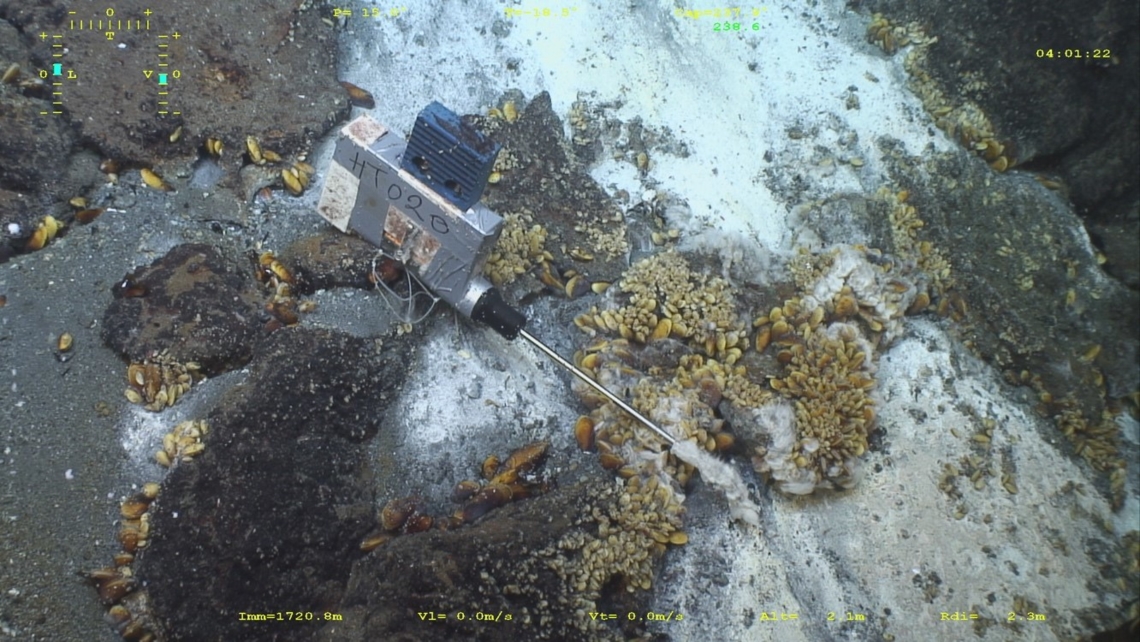The rhythm of the tides, internal clock of hydrothermal fluids exits
Only a fraction of hydrothermal effluents escape in the form of black smokers, in which case they are very hot (up to 350 ° C), loaded with metals, and burst at several tens of centimeters per second out of massive sulphide chimneys. Most hydrothermal fluids, however, come out more slowly next to the smokers, most commonly through cracks. These so-called diffuse fluids, less hot, and mixed with sea water, are the main habitat of the hydrothermal fauna. We have set ourselves the goal of understanding how they are formed, and what mechanisms control their temperature and their chemistry, two parameters essential for the life of organisms.
To do this, we have set up a tight network of temperature, current and pressure sensors, supplemented by regular sampling to control the chemistry of the fluids. The data shows great variability in temperatures and diffuse fluid chemistry, even between outlets that are only a few meters away. This variability tells us about the complexity of the processes in the bedrock of hydrothermal sites: hot, black smoker-type fluids mix with seawater, seawater is heated up, chemical compounds precipitate or are dissolved, modifying the permeability structure of the substratum. However, one constant emerges: all the fluid outflows bear witness to the impact of the tides. With an average amplitude of only one meter or less, these tides induce an overpressure at the seafloor (at a depth of 1700 m) every 12 hours, modifying the permeability of the bedrock. The tides also impact near-seafloor currents, inducing changes in current direction and velocity. These effects modify the local hydrology, both above and below the seafloor and induce variations in the effluents temperature and chemistry which punctuate the life of the hydrothermal fauna.
A probe records the temperature of diffuse hydrothermal effluents on the Lucky Strike field. These diffuse fluids provide the chemical elements necessary for the life of the hydrothermal fauna (here mainly bacterial mats and mussels). Their temperature varies, sometimes by several degrees, with the rhythm of the tides.
← Read the 10 success stories published to celebrate 10 years of monitoring on EMSO-Azores → |
Reference
Girard F., Sarrazin J., Arnaubec A., Cannat M., Sarradin P., Wheeler B., Matabos M., 2020. Currents and topography drive assemblage distribution on an active hydrothermal edifice. Progress in Oceanography 187. DOI: 10.1016/j.pocean.2020.102397
Chavagnac, V., Leleu, T., Fontaine, F., Cannat, M., Ceuleneer, G., and Castillo, A., 2018, Spatial Variations in Vent Chemistry at the Lucky Strike Hydrothermal Field, Mid-Atlantic Ridge (37°N): Updates for Subseafloor Flow Geometry From the Newly Discovered Capelinhos Vent: Geochemistry, Geophysics, Geosystems, v. 55, no. 2, p. 229–15, doi: 10.1029/2018GC007765.
Escartin, J., Barreyre, T., Cannat, M., Garcia, R., Gracias, N., Deschamps, A., Salocchi, A., Sarradin, P.M., Ballu, V., 2015. Hydrothermal activity along the slow-spreading Lucky Strike ridge segment (Mid-Atlantic Ridge): Distribution, heatflux, and geological controls. Earth and Planetary Science Letters. https://doi.org/10.1016/j.epsl.2015.09.025
Barreyre, T., Escartin, J., Sohn, R., & Cannat, M. (2014). Permeability of the Lucky Strike deep-sea hydrothermal system: Constraints from the poroelastic response to ocean tidal loading. Earth and Planetary Science Letters, 408, 146-154.
Barreyre, T., Escartín, J., Sohn, R.A., Cannat, M., Ballu, V., and Crawford, W., 2014, Temporal variability and tidal modulation of hydrothermal exit‐fluid temperatures at the Lucky Strike deep‐sea vent field, Mid‐Atlantic Ridge: Journal of Geophysical Research,, p. 1–24, doi: 10.1002/(ISSN)2169-9356.
Barreyre, T.+, Escartin, J., Garcia, R., Cannat, M., Mittelstaedt, E., and Prados, R., 2012, Structure, temporal evolution, and heat flux estimates from the Lucky Strike deep-sea hydrothermal field derived from seafloor image mosaics. Gcubed v. 13, no. 4, p. Q04007, doi:04010.01029/02011GC003990.


